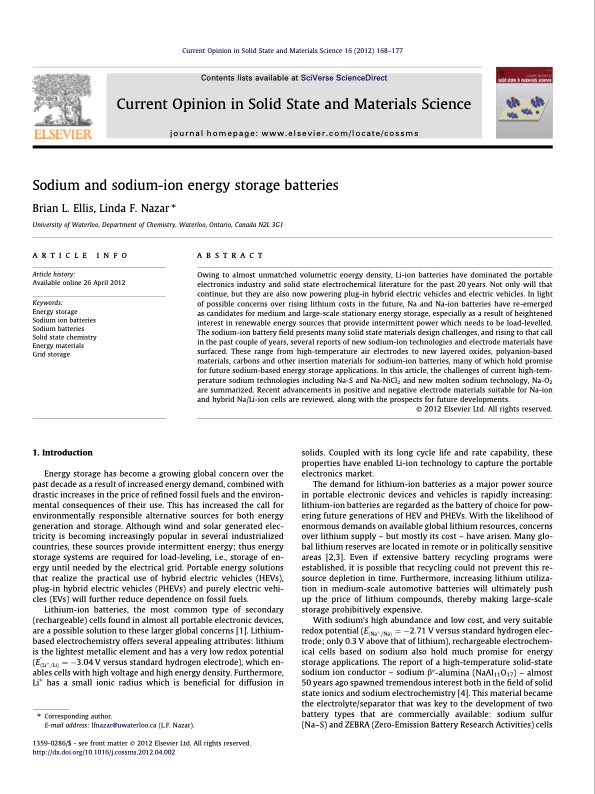
PDF Publication Title:
Text from PDF Page: 002
Current Opinion in Solid State and Materials Science 16 (2012) 168–177 Contents lists available at SciVerse ScienceDirect Current Opinion in Solid State and Materials Science journal homepage: www.elsevier.com/locate/cossms Sodium and sodium-ion energy storage batteries Brian L. Ellis, Linda F. Nazar ⇑ University of Waterloo, Department of Chemistry, Waterloo, Ontario, Canada N2L 3G1 article info Article history: Available online 26 April 2012 Keywords: Energy storage Sodium ion batteries Sodium batteries Solid state chemistry Energy materials Grid storage 1. Introduction Energy storage has become a growing global concern over the past decade as a result of increased energy demand, combined with drastic increases in the price of refined fossil fuels and the environ- mental consequences of their use. This has increased the call for environmentally responsible alternative sources for both energy generation and storage. Although wind and solar generated elec- tricity is becoming increasingly popular in several industrialized countries, these sources provide intermittent energy; thus energy storage systems are required for load-leveling, i.e., storage of en- ergy until needed by the electrical grid. Portable energy solutions that realize the practical use of hybrid electric vehicles (HEVs), plug-in hybrid electric vehicles (PHEVs) and purely electric vehi- cles (EVs) will further reduce dependence on fossil fuels. Lithium-ion batteries, the most common type of secondary (rechargeable) cells found in almost all portable electronic devices, are a possible solution to these larger global concerns [1]. Lithium- based electrochemistry offers several appealing attributes: lithium is the lightest metallic element and has a very low redox potential (EðLiþ =LiÞ 1⁄4 3:04 V versus standard hydrogen electrode), which en- ables cells with high voltage and high energy density. Furthermore, Li+ has a small ionic radius which is beneficial for diffusion in ⇑ Corresponding author. E-mail address: lfnazar@uwaterloo.ca (L.F. Nazar). 1359-0286/$ - see front matter Ó 2012 Elsevier Ltd. All rights reserved. http://dx.doi.org/10.1016/j.cossms.2012.04.002 abstract Owing to almost unmatched volumetric energy density, Li-ion batteries have dominated the portable electronics industry and solid state electrochemical literature for the past 20 years. Not only will that continue, but they are also now powering plug-in hybrid electric vehicles and electric vehicles. In light of possible concerns over rising lithium costs in the future, Na and Na-ion batteries have re-emerged as candidates for medium and large-scale stationary energy storage, especially as a result of heightened interest in renewable energy sources that provide intermittent power which needs to be load-levelled. The sodium-ion battery field presents many solid state materials design challenges, and rising to that call in the past couple of years, several reports of new sodium-ion technologies and electrode materials have surfaced. These range from high-temperature air electrodes to new layered oxides, polyanion-based materials, carbons and other insertion materials for sodium-ion batteries, many of which hold promise for future sodium-based energy storage applications. In this article, the challenges of current high-tem- perature sodium technologies including Na-S and Na-NiCl2 and new molten sodium technology, Na-O2 are summarized. Recent advancements in positive and negative electrode materials suitable for Na-ion and hybrid Na/Li-ion cells are reviewed, along with the prospects for future developments. Ó 2012 Elsevier Ltd. All rights reserved. solids. Coupled with its long cycle life and rate capability, these properties have enabled Li-ion technology to capture the portable electronics market. The demand for lithium-ion batteries as a major power source in portable electronic devices and vehicles is rapidly increasing: lithium-ion batteries are regarded as the battery of choice for pow- ering future generations of HEV and PHEVs. With the likelihood of enormous demands on available global lithium resources, concerns over lithium supply – but mostly its cost – have arisen. Many glo- bal lithium reserves are located in remote or in politically sensitive areas [2,3]. Even if extensive battery recycling programs were established, it is possible that recycling could not prevent this re- source depletion in time. Furthermore, increasing lithium utiliza- tion in medium-scale automotive batteries will ultimately push up the price of lithium compounds, thereby making large-scale storage prohibitively expensive. With sodium’s high abundance and low cost, and very suitable redox potential (EðNaþ =NaÞ 1⁄4 2:71 V versus standard hydrogen elec- trode; only 0.3 V above that of lithium), rechargeable electrochem- ical cells based on sodium also hold much promise for energy storage applications. The report of a high-temperature solid-state sodium ion conductor – sodium b00-alumina (NaAl11O17) – almost 50 years ago spawned tremendous interest both in the field of solid state ionics and sodium electrochemistry [4]. This material became the electrolyte/separator that was key to the development of two battery types that are commercially available: sodium sulfur (Na–S) and ZEBRA (Zero-Emission Battery Research Activities) cellsPDF Image | Sodium and sodium-ion energy storage batteries

PDF Search Title:
Sodium and sodium-ion energy storage batteriesOriginal File Name Searched:
2012_Na-battery_review.pdfDIY PDF Search: Google It | Yahoo | Bing
Salgenx Redox Flow Battery Technology: Salt water flow battery technology with low cost and great energy density that can be used for power storage and thermal storage. Let us de-risk your production using our license. Our aqueous flow battery is less cost than Tesla Megapack and available faster. Redox flow battery. No membrane needed like with Vanadium, or Bromine. Salgenx flow battery
| CONTACT TEL: 608-238-6001 Email: greg@salgenx.com | RSS | AMP |